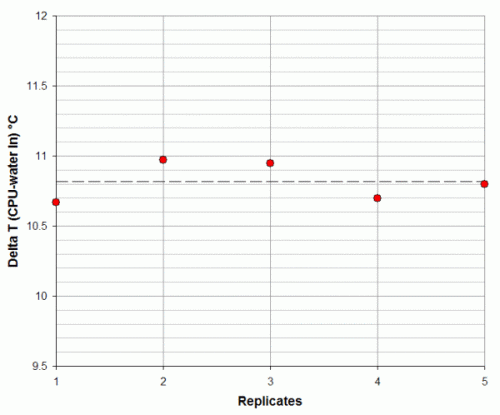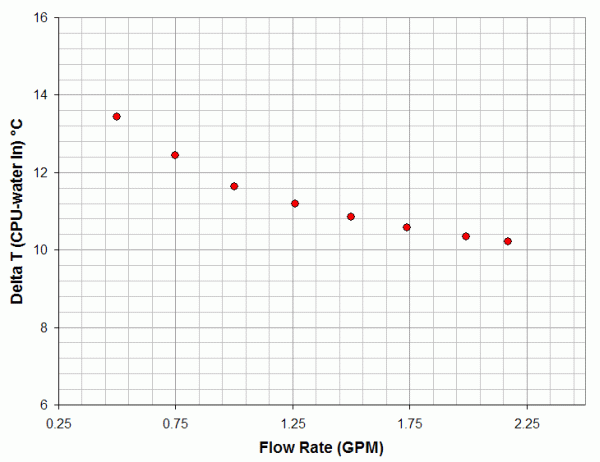|
|
|
|
 Jaydee's Lumpy Channel Waterblock review Jaydee's Lumpy Channel Waterblock review
|
|
Date Posted: Jun 16 2004
|
|
Author: pHaestus
|
|
|
|
|
Posting Type: Review
|
|
Category: H2O and High End Cooling Reviews
|
|
Page: 1 of 1
|
Article Rank: from 1 Readers
Must Log In to Rank This Article from 1 Readers
Must Log In to Rank This Article
|
|
|
|
|
Note: This is a legacy article, imported from old code. Due to this some items on the page may not function as expected. Links, Colors, and some images may not be set correctly.
|
|
|
Jaydee's Lumpy Channel Waterblock review By: pHaestus
|
|
|
JayDee's Lumpy Channel Waterblock Review
By: pHaestus 6/16/04
|
|
|
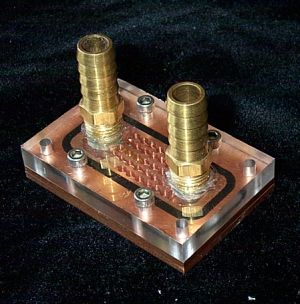 JayDee is a Proforums regular and has been making waterblocks (and flaming idiots) for many years. One of the main reasons I set up my test bench was to give DIY waterblock designers in our
Design forum a chance to have the performance of their waterblocks properly evaluated. JayDee sent me several waterblocks to review; the first of his creations is the Lumpy Channel block. JayDee is a Proforums regular and has been making waterblocks (and flaming idiots) for many years. One of the main reasons I set up my test bench was to give DIY waterblock designers in our
Design forum a chance to have the performance of their waterblocks properly evaluated. JayDee sent me several waterblocks to review; the first of his creations is the Lumpy Channel block.
The Lumpy Channel waterblock is a two barb design that features multiple irregular channels. It is reminiscent of the BeCooling SlitEdge
waterblock, but with a more complicated internal structure. Here's what JayDee had to say about his creation:
"Goals of this block: (1) Easy to mill. (2) Good performance (3) 2 barbs. I was successful in all of
these goals. The block is a simple design. The holes are 1/8" and they are connected with a 1/16" endmill. The base material is C110 Copper 2" (W) x 3"
(L) x 1/4" (T). The hole and outer channel depth is 3/16". That leaves 1/16" of base. The block was milled out on my little Sherline 5400 mill that has a CNC conversion from acumotion. The top is Lexan polycarb.
The barbs are 1/2" 1/4NPT threaded brass."
JayDee of Custom Cooled PC
I was quite impressed with the machining and quality of this waterblock. It may be a DIY block, but it is
just as well made as the commercial waterblocks I've tested. The top piece and baseplate are sealed with four bolts and an O-ring for ease of opening and cleaning.
|
|
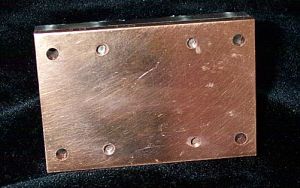 |
|
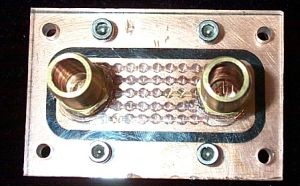 |
|
|
|
|
|
The baseplate of the block had been hand lapped. Overall a very good effort.
|
|
|
Test Results and Observations
|
|
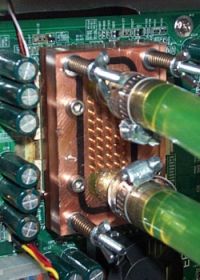 I finally got around to putting together a summary of my testing methods and equipment, so if you want to get the full lowdown on
the Procooling test bench then just give that a read. The same springs and mounting hardware were used in this testing as in all previous "4 hole" designs to ensure the same mounting pressure
was used in all cases. Here is a bit more information on the "delta T" numbers that are used in all the graphs that follow: I finally got around to putting together a summary of my testing methods and equipment, so if you want to get the full lowdown on
the Procooling test bench then just give that a read. The same springs and mounting hardware were used in this testing as in all previous "4 hole" designs to ensure the same mounting pressure
was used in all cases. Here is a bit more information on the "delta T" numbers that are used in all the graphs that follow:
I measure CPU diode temperature, the temperature of the water at the waterblock's inlet, and the water flow rate. By plotting the
difference between CPU temperature and water temperature, we can normalize all testing. This is required because water temperatures may vary from day to day in my testing room. The closer that this
delta T (engineering-speak for temperature differential) is to 0, the better the waterblock is performing.
I found the Lumpy Channel block to be very easy to mount and use and it was watertight. There were no problems with using hose clamps or wingnuts on this block.
The first test I conduct is the variation of waterblock performance over repeated mounting replicates at 1.50 GPM flow rate:
|
|
Over five mountings the average temperature difference between CPU diode and water inlet was 10.82C, and the standard deviation was 0.14. That's good
enough for me so I stopped there. I seem to be now approaching competency at block mounting and thermal paste application.
The next test conducted is the relationship between waterblock performance and flow rate:
|
|
The Lumpy Channel waterblock's performance improves pretty steadily with increasing flow rate.
It reminds me a bit of the Dangerden waterblocks, although the low flow rate performance dropoff is not as dramatic with the Lumpy Channel block.
It is also useful to plot the performance of the Lumpy Channel waterblock versus other commercial blocks I have tested:
|
|
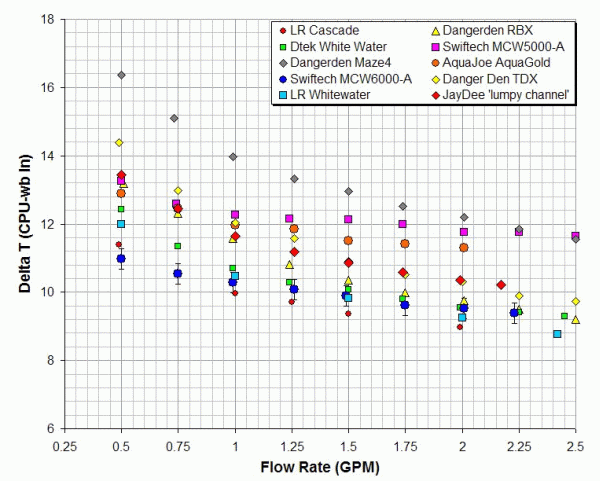 |
|
This graph is getting pretty busy, but if you look closely at the performance of the Lumpy Channel block it falls almost perfectly on top of the Dangerden TDX
between 1.25 and 2.0 GPM. At flow rates below 1.25GPM the Lumpy Channel waterblock outperforms the TDX. The Lumpy Channel block is more restrictive than the TDX though and its performance at 2.25 and 2.5GPM is
better than the Lumpy Channel waterblock can muster. This block design seems to be a pretty good choice for the DIY crowd though; it performs much better than the pin grid block from #rotor and can be made with the same
tools (drill press plus dremel).
Thanks again to JayDee for letting me test this block.
|
|
|
|
| Random Forum Pic |
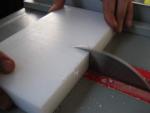 |
| From Thread: Chieftec big tower wc'ing in progress |
|
| | ProCooling Poll: |
| So why the hell not? |
|
I agree!
|
 67% 67%
|
|
What?
|
 17% 17%
|
|
Hell NO!
|
 0% 0%
|
|
Worst Poll Ever.
|
 17% 17%
|
Total Votes:18Please Login to Vote!
|
|






 Jaydee's Lumpy Channel Waterblock review
Jaydee's Lumpy Channel Waterblock review
 from 1 Readers
Must Log In to Rank This Article
from 1 Readers
Must Log In to Rank This Article
 JayDee is a Proforums regular and has been making waterblocks (and flaming idiots) for many years. One of the main reasons I set up my test bench was to give DIY waterblock designers in our
Design forum a chance to have the performance of their waterblocks properly evaluated. JayDee sent me several waterblocks to review; the first of his creations is the Lumpy Channel block.
JayDee is a Proforums regular and has been making waterblocks (and flaming idiots) for many years. One of the main reasons I set up my test bench was to give DIY waterblock designers in our
Design forum a chance to have the performance of their waterblocks properly evaluated. JayDee sent me several waterblocks to review; the first of his creations is the Lumpy Channel block.


 I finally got around to putting together a
I finally got around to putting together a 